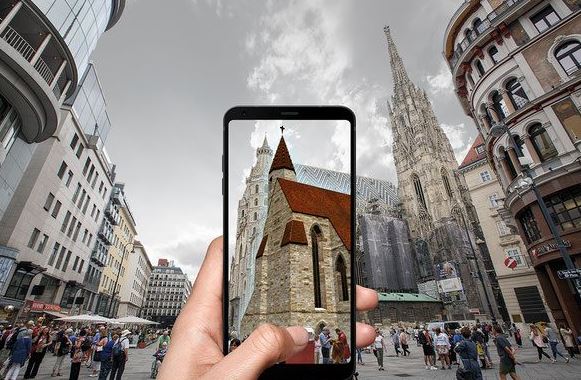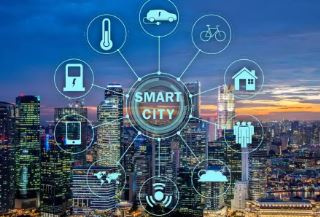Introduction to AR’s Transformative Role
In the AR’s transformative role, augmented reality, which integrates digital content with the physical world, is revolutionizing various industries. In urban planning and smart city development, AR is making a significant impact in providing new ways to visualize design, collaborate, and engage the public. This technology offers exciting possibilities for creating a more interactive and immersive experience in the field. Both planners and architects visualize the digital models of infrastructures. Moreover, it gives a visualized appearance with a finalized design in a practical way. Also, it proposes developments and enhancements with urban changes. The AR allows interactive development plans with 3D exposure.
AR in smart city development

Augmented Reality for Urban Planning and Smart City Development
Visualizing future enhancements
Augmented city planners and the public reality are transforming urban planning, which allows both and city planners to view the proposed development in the real world. Instead of depending on blueprints or the enhanced with 3D models (Boos, Reichenbacher, Kiefer, & Sailer, 2022). Augmented reality allows everyone to view parks, buildings, and integrated architecture. Moreover, this has enhanced the visualized scope for future developments and greater involvement with the community.
Interactive zoning and land use information
Particularly , AR enhances urban planning with enablement of creation of dynamic zoning and users Internet with the smartphones. The residence uses a simple point of specific location and instantly received detailed information regarding zoning regulations, land use rules and further developments in that area (Brant, 2023). Also, interactive experience enhances the planning process and empowers people.
Improvement of public engagement
Generally, public engagement plays a key role in Urban Development where AR is making this process accessible to all the people and engaged. With the help of AR, the residents participate in virtual hall meetings where they discuss the projects in their environment (Jha & Joshi, 2019). In addition, the virtual interaction enhances feedback and incorporates enhanced decision making and planning.
Minimizing planning errors
With the proposed developments in current urban development, AR allows planners to identify the major issues before the construction starts. Moreover, it enables to access the traffic impact and environmental factor assessment. This approach provides the elimination of errors in planning and expensive charges during construction.
Promoting sustainability and green development
Augmented reality plays a significant role in encouraging sustainable practices in urban planning. It allows residents to explore various aspects, such as sustainable infrastructure, green space, and parks (YagoI, Ramos, Trilles, Torres-Sospedra, & Perales, 2018). The virtual exploration supports initiating environmentally friendly practices and prioritizes particularly eco-conscious projects in the enhancement of development project plans.
AR’s Transformative Role

Challenges and opportunities of augmented reality in urban planning and smart city development
When augmented reality holds great promise in revolutionizing architecture with several challenges and widespread adoption. However, there are challenges but there are also significant opportunities to shape the cities.
Technological limitations
One of the major challenges is the accuracy of data with AR application full store the effectiveness of AR depends on the digital structure placed in the physical world. The accuracy of this virtual representation of traffic patterns and environmental changes should be flawless. There should be updated data that is available with the VR application. This also includes building groupings gamma environmental data gamma and geographic information. If the data is outdated then there is a chance of misleading integration of data and it is challenging for developers to enhance the project.
Privacy and security concerns
With the usage of AR applications, there is a large amount of data involved. For example, when there is an engagement with an application in a public space, there is sensitive data involved, and there is a chance of data. The use of AR in urban planning requires both preferences and behaviors of individual data. Therefore, to address these concerns, the developers ensure robust practices to enhance the security and implement privacy protection measures.
Opportunities of Growth
Despite the challenges, the AR provides the fulfilled experience of opportunities. As the continuous technology development evolves there is a cost that is expected to decrease with a wider range of organizations. By using advanced implementation most technologies help in the dynamic approach of the urban model. One of the greatest opportunities is community involvement where it empowers citizens to actively participate in the development.
Case Studies
IKEA Place App
For example, the application helps individuals to virtually place the furniture of IKEA in the home by offering a great visual representation of how different pieces will fit in their home within a specified area (Joseph, 2024). This tool helps to make informed decisions with the visualization of furniture in the enhanced environment before placing it.
City planning simulation
In various cities the augmented reality presence of proposed solution for Urban Development. The simulations enhance the citizens to see how the roads and public spaces are used. It offers future cities game with aids community engagement and overall understanding of potential impact of project.
Architectural visualization tools
It has many software companies developed with an immersive design experience. Tools help to analyze the digital models in a world environment and more planning process for architecture. Moreover, these tools help to analyze the structure and improve collaboration between the clients and designers and enhance decision making.
Conclusion
AR’s transformative role plays a potential role in offering real-time visualization and enhancing infrastructure management. With the integration of smart city management provides an innovative environment in urban planning. Also, it continues to make advancements and plays a significant role in shaping the future and making the city smart. In addition, the AR helps to analyze and create urban spaces with more suitable and modern residences. Also, it transforms the smart city development and future leads to promising development. To conclude, the AR empowers the public, architects, and planners to make enhanced decision-making and continues to evolve in limitless digital experience.
References
Boos, U. C., Reichenbacher, T., Kiefer, P., & Sailer, C. (2022). An augmented reality study for public participation in urban planning. Journal of Location Based Services, 17(1), 48–77. Retrieved from https://www.tandfonline.com/doi/full/10.1080/17489725.2022.2086309
Brant, J. (2023, Sep 25). Augmented Reality (AR) for Urban Design: Shaping the Future of Smart Cities. Retrieved from Linkedin: https://www.linkedin.com/pulse/augmented-reality-ar-urban-design-shaping-future-smart-jess-brant
Jha, S., & Joshi, S. (2019). Role of Augmented Reality Applications for Smart City Planning. International Journal of Innovative Technology and Exploring Engineering, 8(8), 2278-3075. Retrieved from https://www.researchgate.net/publication/348382530_Role_of_Augmented_Reality_Applications_for_Smart_City_Planning
Joseph, S. (2024, Aug 17). Augmented Reality: A New Dimension in Architecture and Urban Planning. Retrieved from Medium: https://medium.com/@staneyjoseph.in/augmented-reality-a-new-dimension-in-architecture-and-urban-planning-f210dca0061c
YagoI, P., Ramos, F., Trilles, S., Torres-Sospedra, J., & Perales, F. J. (2018). New Trends in Using Augmented Reality Apps for Smart City Contexts. International Journal of Geo-Information, 7(12), 1-23. Retrieved from https://www.mdpi.com/2220-9964/7/12/478
Keywords
Urban planning, Smart city development, Augmented reality,
Relevant Articles
AR & VR: Shaping the future of E-commerce
Read More about the Topic
Role of Augmented Reality Applications for Smart City Planning
Augmented Computing and Smart Cities Sustainability
Read More about the Topic
Role of Augmented Reality Applications for Smart City Planning
Smart city as urban innovation: focusing on management, policy, and context
